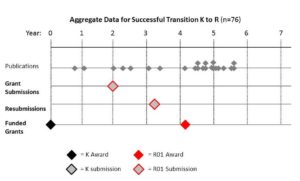
If you want to be off your K or similar career development award before the end of five years, the calendar will tell you that you can’t start later than the third year to submit a substantial grant. For convenience let’s call that major grant an R01 though it could be a VA Merit, NSF award, or other large grant.
Due dates and review timelines can tell you all you need to know. This is not top secret mentoring mojo. Let’s imagine your career development award runs from September 2022 through end of August 2027. Assuming you do not walk on water but your science is compelling, you will need two submissions: a first and a revised submission. You need to arrive at your destination before August of 2027 to avoid speculation about whether you will succeed in transitioning to independence before the end of your career development award. You must avoid a need for bridge funding to be considered completely successful in taking flight on time.
As a rule of thumb a grant of at least $250K direct costs per year for at least three years is a solid win and an R01 or similar with greater award amount or duration is a gold standard win. That means conventional federal review timelines prevail (NIH application and review dates). Let’s back it out:
If you submit your first application in June of 2026 (about 3.5 years into your CDA) it will be reviewed in October or November of 2026* and you will get summary statements just in time to disturb your holidays but likely not in time for November 5, 2026 resubmission. Unless your score is near perfect you will aim to resubmit by the next resubmission window which is March 2027. That means review of your resubmission will be in summer of 2027 with earliest funding start dates of September to December 2027. That’s a painful nail-biting experience (remember your CDA ends in August 2027), especially if you have a tenure and promotion review in the same window.
So, we’re agreed…for sanity and safety, you need to submit earlier. If possible with enough time to get in a full round of submission and start another if (bummer) you crash completely on the first try.

Conclusion: Grant year two or beginning of year three is the optimal zone. Hope you considered this going into your CDA. A K-award or similar does not give you five years to gather preliminary data and write papers. It gives you 2.5 to 3 years of running room but with potential joy of up to 2 years of overlap for salary support on the K while you start your R01. It is only too early to start if you aren’t competitive for larger grants yet. (We have seen researchers with tight science succeed with first applications in the first year of a CDA.)
Implication: Don’t start a CDA (or concurrent tenure track timeline) until you know you have solid science underway. You can’t beat the clock. It takes time to compete for major grants because of the review and funding cycle and low paylines. Don’t be naive about this – pass it on.
Your major grant needs to be ready for take off at the halfway mark of five year awards.
*Dates approximate from current NIH review schedules; individual study sections and review of RFAs will vary but are rarely faster.
